In this new series Nirmala
View(s):M. Peiris looks at edible leafy greens that are packed with nutrients and bursting with important health benefits Sambol is a Sri Lankan salad prepared using raw ingredients. Leafy green sambols (sambolaya in Sinhala and sambal in Tamil) are eaten by all segments of society in Sri Lanka. This is because the greens are relatively inexpensive, easy to find, preparation is quick and it is a delicious nutritionally healthy side dish.
For the preparation of sambol, always use young tender leaves (kola in Sinhalese, Ilaikaḷ in Tamil). The leaves must be sliced very finely, (usually done by rolling a few leaves together before chopping), then mixed with cut red onions, green chillies, fresh grated coconut and seasoned with salt and lime juice. Some maldive fish flakes and powdered pepper can be added if preferred. In the case of karapincha and minchi, the mixture must be finely ground due to the highly fibrous nature of the leaf. Add a few cloves of garlic to zest it up.
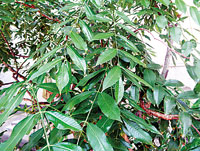 Ambarella
Ambarella
Spondiasdulcis (ambarella), in the family Anacardi-aceae is a fast growing deciduous tree. The leaves are pinnate, glossy, and oblong finely toothed towards the apex. Young leaves are appealingly acidic and contain many flavonoids that have antioxidant properties and saponins that help lower cholesterol. The tannins in the leaves are a useful remedy to cure dysentery and due to its antifungal properties are also used for oral thrush and cracked tongue.
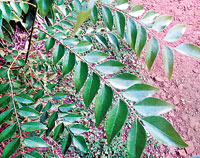 Karapincha
Karapincha
Karapincha (curry leaf), Murrayakoenigii in the family Rutaceae is used as a natural flavouring for curries. It is a small tree, with aromatic pinnate leaves. The leaves are rich in protein and beta-carotene while calcium, phosphorous and vitamin C are also present in adequate amounts. Curry leaves are effective in the control of high blood pressure, heart disease, diabetes and reducing LDL cholesterol levels. Karapincha also protects the liver and helps in fighting bacterial and fungal infections.It has the ability to increase appetite, control digestion,diarrhoea, excessive acid secretion and peptic ulcers. Moreover the leaves improve hair growth and reduce hair loss.
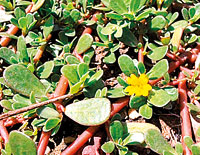 Genda
Genda
Genda (purslane), (Portulacaoleracea) in the family Portulacaceae has smooth, reddish, mostly prostrate stems with fleshy leaves. The leaves are rich in dietary fibre and minerals. It is an excellent source of vitamin A, one of the highest among green leafy vegetables and is also a rich source of vitamin C, and some B-complex vitamins. Fresh leaves contain more omega-3 fatty acids than any other leafy vegetable.This fatty acid reduces the risk of coronary heart disease, stroke, and helps prevent the development of ADHD (Attention Deficit Hyperactivity Disorder) and autism. It also protects the skin, boosts vision, strengthens the immune system, builds strong bones and increases circulation.
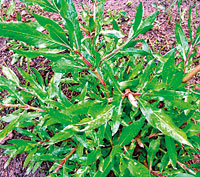 Nerramulliya
Nerramulliya
Nerramulliya (marsh barbell) scientifically Hygrophilaauriculata in the family Acanthaceae is a perennial evergreen shrub native to Sri Lanka and India. The plant grows naturally in the wet zone or dry zone in the low country near water bodies or marsh lands. Stems are erect, nearly unbranched and thickened at nodes. Leaves are simple each having a slightly arched, sharp, yellow spine.The leaves are good for urinary tract infections and rheumatism. It contains phytosterols, that are plant sterols structurally similar to cholesterol that act in the intestine to lower cholesterol absorption.
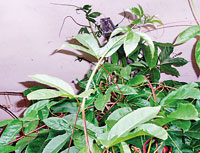 Passion fruit
Passion fruit
Passion fruit (Passifloraedulis) in the family Passifloraceae are mostly vines. The leaves are either three or five lobed depending on the variety and are available throughout the year. Passion fruit leaves are a good source of vitamin C and also vitamin A and niacin. The leaves have diuretic properties as it contains alkaloids, including Harman and thus is active against high blood pressure. It also has sedative and anti-spamosdic action and is used for haemorrhoidal inflammations, headaches and general pain relief.
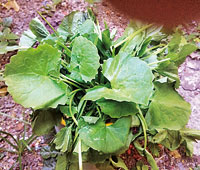 Gotukola
Gotukola
Centellaasiatica, commonly known as gotukola, is a small herbaceous perennial plant of the family Apiaceae. The stems are slender, creeping stolons, connecting plants to each other. It has long-stalked, green, rounded leaves and is a good source of minerals and vitamins B and C. Gotukola is a mild diuretic and is thus able to regulate blood pressure and reduce strain on the cardiovascular system. The calming effect of gotukola that reduces stress and stimulates healthy sleep also soothes the nervous system. Moreover, gotukola has the ability to speed wound healing and improve skin health.
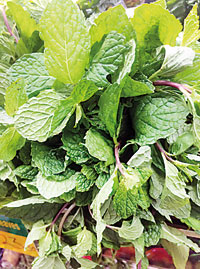 Minchi
Minchi
Menthalongifolia, mint(minchi) is a genus of plants in the family Lamiaceae. Mints are aromatic and have wide-spreading creeping horizontal plant stems or runners that take root at points along its length to form new plants. The leaves are oblong with a serrated margin. Minchi sambol is always served with biryani. Mint leaves are widely used as a digestive aid, relieving cramps and gas and alleviating indigestion. Mint contains high levels of rosmarinic acid, an antioxidant that quenches free radicals and reduces allergy symptoms due to its anti-inflammatory and antioxidant effects.
 Welpenela
Welpenela
Welpenela, the balloon vine (Cardiospermumhalicacabum) in the family Sapindaceae is an annual herb which is very common in the low country and throughout the tropics. It is a small delicate climber. Its leaves are alternate, leaflets are coarsely toothed and the seeds are in three tangled capsules.Welpenela is propagated by its seeds. It is a well-known traditional herb for nerve strengthening and nerve diseases. Thereby it provides synergistic effects to enhance sexual performance. The roots and leaves are used in rheumatism, nerve diseases, piles, chronic bronchitis and tuberculosis.
Kirianguna
 Kirianguna/thiththaanguna (Wattakkavolubilis or Dregeavolubilis) in the family Apocynaceae is a slightly woody climber distributed in dry lowlands. Leaves are ovate or somewhat rounded, rather leathery, and pointed at the tip. Kirianguna leaves are usually smaller than the thithaanguna leaves which are rather bitter. The leaves contain vitamin C, tannins, steroids, flavonoids, and triterpenoids. Kirianguna has been reported to have anti-diabetic, anti-cholesterol and anti-inflammatory properties.
Kirianguna/thiththaanguna (Wattakkavolubilis or Dregeavolubilis) in the family Apocynaceae is a slightly woody climber distributed in dry lowlands. Leaves are ovate or somewhat rounded, rather leathery, and pointed at the tip. Kirianguna leaves are usually smaller than the thithaanguna leaves which are rather bitter. The leaves contain vitamin C, tannins, steroids, flavonoids, and triterpenoids. Kirianguna has been reported to have anti-diabetic, anti-cholesterol and anti-inflammatory properties.
Kovakki
Cocciniagrandis, the ivy gourd, also known as scarlet gourd, baby watermelon and kovakki in the family Cucurbitaceae is a tropical vine, grown for its edible young shoots and fruits. Leaves are palmate with five lobes while the shape differs from heart to pentagon form. The leaves are a good source of nutrients, vitamins and mineral. Compounds in the leaves inhibit the enzyme glucose-6-phosphatase. This compound is one of the key liver enzymes involved in regulating sugar metabolism and thus recommended for diabetic patients. It is also used to treat high blood pressure bronchitis, burns, skin eruptions, syphilis and gonorrhea, jaundice and rheumatism.
Thebu
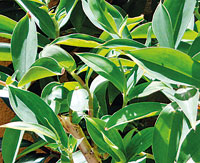 Thebu (Costusspeciosus) in the family Zingiberaceae also called crepe ginger is a perennial rhizomatous herb with erect or spreading stems found in shady places of the low country. The dark green obovate leaves are spirally arranged around the green trunk. The leaves contain proteins, carbohydrates, nutritional fibre, minerals and many vitamins. Thebu leaves contain the steroid diosgenin which is anti-diabetic in nature and thus especially good for diabetes patients. The leaves also possess hypoglycemic properties and insulin potentiating action in addition to decreasing blood glucose and thus must be eaten in moderation. The leaves can also stimulate appetite, control phlegm and bile and treat skin issues.
Thebu (Costusspeciosus) in the family Zingiberaceae also called crepe ginger is a perennial rhizomatous herb with erect or spreading stems found in shady places of the low country. The dark green obovate leaves are spirally arranged around the green trunk. The leaves contain proteins, carbohydrates, nutritional fibre, minerals and many vitamins. Thebu leaves contain the steroid diosgenin which is anti-diabetic in nature and thus especially good for diabetes patients. The leaves also possess hypoglycemic properties and insulin potentiating action in addition to decreasing blood glucose and thus must be eaten in moderation. The leaves can also stimulate appetite, control phlegm and bile and treat skin issues.
Akkapana
Bryophyllumpinnatum (Akkapana) in the family Crassulaceae is a succulent perennial herb. The leaves are large, broad and oval or elliptic with rounded tips and have scalloped margins. A number of active compounds, including flavonoids, glycosides, steroids, bufadienolides and organic acids have been identified in the plant. It is a natural treatment for kidney and gallbladder stones and also useful for urinary disorders. Moreover, the leaves are beneficial in controlling blood pressure, blood flow in diarrhoea and have been found to have anti-viral, anti-bacterial, anti-fungal and anti-cancer properties.
Kurinnan
Kurinnan, (Gymnemalactiferum) is a twining plant which belongs to the family Asclepiadaceae.The leaves are ovate and have a smooth surface. The principle active ingredient is Gymnemic acid which exhibits anti-sweet activity and at the same time suppresses glucose absorption from the intestine. It is commonly used as treatment for diabetes. It has also earned significant recent interest as a multi-supportive therapy for weight management, has diuretic, anti-inflammatory and laxative properties and is used to treat gastrointestinal disorders such as constipation and gas problems.
Asamodagam
Trachyspermumroxburghianum (Asamodagam) is a flowering plant belonging to the family Apiaceae.Also known as wild celery it is an erect, branched annual herb about 6 to 8 inches in height. The crystalline ketonic substance present in the leaves exhibit powerful antispasmodic activity, the action being particularly marked on the stomach smooth muscle and thus a useful remedy for stomach ailments. It is also considered to have very good anti-gas properties, so is used as an after-meal digestive.
Storage and pre-preparation
Whether leafy greens are produced organically or conventionally, purchased from a farmers’ market, pola or supermarket, served cooked or raw, storage and pre-preparation of the leaves are most important. Plan your purchases to use the leaves as soon as possible as greens may wilt and spoil before you can use them. Immediately after purchase, if the leaves are bundled, untie the bundle, go through the leaves and stems and discard any that don’t look good. If you are not using the leaves immediately, cut off and discard portions such as roots that contain mud and sand. Then lay the leaves out thinly on a clean tea towel or a paper towel to remove as much moisture as possible, and then refrigerate lightly wrapped in a dry towel. Do not wash before storing as this can promote bacterial growth and speed up spoilage. If you are plucking leaves from your home-garden, pluck only when required.
Washing the leaves must be done just before cutting, for mixing or cooking and serving. Always start with clean hands. Wash your hands for 20 seconds or more with soap and warm water. Cut away any damaged areas on leaves or stems, if something seems rotten or discoloured discard it.
Wash the leaves thoroughly under plenty of running water or fill a large bowl with cold water add the greens and swish them around to loosen and remove any sand, mud or dirt. Dirt and debris will sink to the bottom while the greens will float above all the mess. Repeat the process if necessary. Washing is required not only to remove dirt and debris but also to remove any pesticide residues that may remain when pesticides are used during cultivation. Almost 75 to 80% of pesticide residues are removed by cold water washing.
Washing with 2% salt water will remove most of the contact pesticide residues that normally appear on the surface. Washing the leafy greens properly is the key to food safety.
Caution – Never wash leafy greens with soap, detergent or bleach, since these can leave residues that are not meant to be consumed.
Other ways of eating greens
The mature leaves of ambarella, anguna, kurinnan and passion fruit are also used for making mallung which is a traditional cooked preparation with grated coconut, while gotukola, karapincha and welpenela are heavily used for making ‘kola kenda’ (herbal porridge). Minchi when made into a sauce is an indispensable accompaniment to roast lamb.


